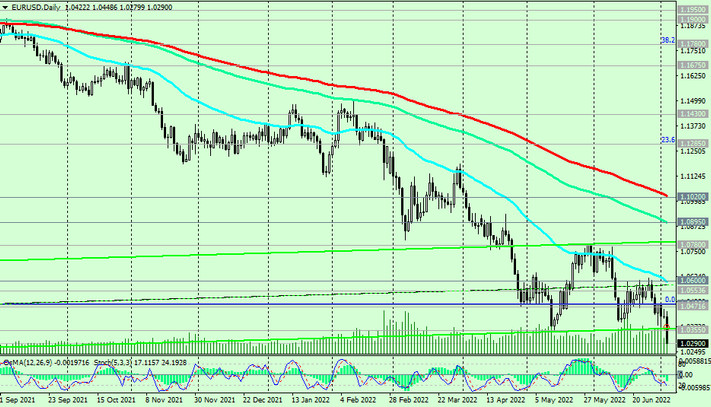Today (the its first half) was marked by a sharp strengthening of the dollar. Investors returned to the market after a long weekend in the US: on Monday, Americans celebrated Independence Day, and banks and stock exchanges were closed.
The DXY dollar index has jumped 110 points since today's open to hit 106.00, while the euro plunged early into today's European trading session.
EUR/USD for the first 2 hours of the European trading session fell by 1.24%, falling by 128 points to 1.0307, and at the time of publication of this article, the pair was declining to intraday and a new local low (since January 2003) 1.0280.

The euro also fell sharply in major cross pairs.
The euro received a negative impulse yesterday after the German Statistics Office released fresh data on the dynamics of the trade balance: in May, German exports fell by 0.5% after rising by 4.4% a month earlier, and the German trade balance turned out to be deficit in May, amounting to -1 billion euros (the forecast was 2.4 billion euros against 3 billion euros in April). The German economy, as you know, is the locomotive of the entire Eurozone economy. Therefore, the deterioration of the macroeconomic indicators of this country has a negative impact on the euro quotes. In addition, as follows from yesterday's speech by Vice President of the European Central Bank Luis de Guindos, the European economy is close to recession. High energy prices, worsening terms of trade and the negative impact of high inflation on disposable income pose heightened risks to the ECB's medium-term outlook for the Eurozone economy, he said.
At the same time, investor sentiment in the Eurozone deteriorated sharply. This is evidenced by the Sentix investor confidence index published on Monday, which fell to -26.4 in July against the forecast of -19.9 and against the value of -15.8 in May.
The euro ignored the positive macro data published this morning, according to which the S&P composite manufacturing PMI for the Eurozone in June amounted to 52, and the similar PMI in the services sector in June amounted to 53.
Tomorrow at 09:00 (GMT) Eurostat is to publish fresh data on retail sales in the Eurozone. This is the main indicator of consumer spending, showing the change in retail sales. A high result will strengthen the euro, and vice versa, a low result will weaken it. Forecast for May: +0.4% (+5.4% YoY) vs. -1.3% (+3.9% YoY) in April, -0.4% (+0.8% YoY) yoy) in March, +0.3% (+5.0% yoy) in February, +0.2% (+7.8% yoy) in January. The data suggests that, despite rising indices, retail sales have not yet reached pre-coronavirus levels after a sharp drop in March-April 2020, when tight quarantine measures were in place in Europe. However, better-than-expected data is likely to have a positive impact on the euro.
Volatility in the quotes of the euro and the EUR/USD pair will increase at 09:00, however, the greatest volatility in the market and in the EUR/USD pair will still be observed at 14:00 (publication of the PMI index of business activity (from ISM) in the US economic services sector) and at 18:00 (GMT), when the minutes from the June Fed meeting (“FOMC minutes”) will be published. The publication of the minutes is extremely important for determining the course of the current policy of the Fed and the prospects for raising interest rates in the US. Following the meeting, which ended on March 15-16, the leaders of the central bank raised the interest rate by 0.25% (for the first time since 2018) and announced their intention to raise interest rates another 6 times in 2022, also allowing for the possibility of a tougher decision. The soft tone of the protocol will have a positive impact on stock indices and negatively - on the US dollar. The harsh rhetoric of the Fed's leaders regarding the prospects for monetary policy will push the dollar to further growth, including against the euro.





